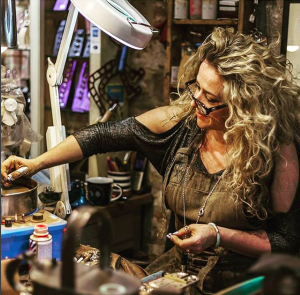
– Her Story –
From the age of seven Sarah has been addicted to Whitby Jet. Like most addicts, it consumes most of her waking day. By the age of eleven she was working jet for pleasure and profit, selling items to friends. By fourteen with the help of her mum Isobel Caldwell, The Ebor Jetworks was established.
However, Sarah was determined to learn more about Whitby Jet scientifically and graduated from University College, Durham with a Degree in Geology in 1992.
She has since qualified as a professional gemmologist and was awarded Fellowship of the Gemmological Association of Great Britain (FGA) in 2013, and subsequently Diamond Fellowship (DGA) in 2015.
Sarah is also a member of the Canadian Gemological Association, The Scottish Gemmological Association and is a Senior Accredited Gemmologist of The International Accredited Gemologists Association.
As such, she is considered the world’s leading authority on the Jet Group of gemstones and is regularly asked to speak and deliver workshops at conferences around the world. She is also a freelance writer and has had articles published in Gems and Jewellery Magazine and Gemmology Today amongst others.
Her recent research collaborations with The National Museums of Scotland and her ongoing research with the University of Yale are challenging our previous perceptions of Jet. Sarah is an honorary research partner of the Asociación Azabache Jurásico de Villaviciosa in Spain, and has also recently been appointed Consultant Gemmologist at Whitby Museum, which is home to the most important collection of Victorian Whitby Jet in the world.

The Legacy of Whitby Jet
We first see Whitby Jet in the archaeological record 5,500 years ago in the Mid-Neolithic increasing in prevalence into the Bronze Age. Some of the most staggering Whitby Jet finds are attributed to the Bronze Age, and the prevalence of Whitby Jet at this period of history leads many Early Prehistorians to suggest that the Bronze Age could arguably have been termed The Jet Age! It’s therefore reasonable to argue that The Bronze Age was therefore the true heyday of Whitby Jet, and not as many suggest the Victorian Era.
The invasion of the Roman Army in C1st BC brought fundamental change to our country. The Roman Empire however was quick to realise the value of Whitby Jet and they had the most skilled craftsmen of the Pre-Victorian era. The first confirmed jet lapidary workshop is in fact Roman and dates from C2nd Eboracum (Roman York). Indeed, our name, The Ebor Jetworks, is a reference to this first workshop, making us the original jetworks!
In 867AD the religious community of Streonshalh (later to become known as Whitby Abbey) was invaded by Viking raiders. They discovered what they believed to be rare black amber. This was of course Whitby Jet. The Vikings established workshops in their trading centre of Jorvik (York) not far from the first workshop from the Roman occupation.
Post 1066 the documented evidence for jet working is scarce. Most authors believe that Whitby Jet was not manufactured at this time, Sarah however believes that we have a continuous production during the mid-late Medieval period, supported by historical accounts from the period.
Fast forward to 1830 and the modern Whitby Jet industry is in it’s infancy. British Society is participating in a national obsession with mourning. With the death in 1830 of George IV, the Lord Chamberlains office dictates the dress code for the period, and states unequivocally that “the ornament shall be jet” and in 1830 the term “jet” meant only one material…Whitby Jet. The death of the Duke of Wellington in 1852 prompted the production of Whitby Jet jewellery into overdrive, the 50 recorded workshops in 1850 then swelled to 204 following the death of Prince Albert in 1861 as yet another wave of mourning sweeps the nation.
The demand for Whitby Jet reaches a crisis in 1860 and alternatives are desperately needed. By chemically or structurally altering other organic materials a reasonable simulant for Whitby Jet is achieveable. In 1839 Robert Goodyear had developed a method to vulcanise rubber, with the addition of dye it was easily mouldable, cheap to produce and a reasonable simulant for jet. Other materials followed, Bois Durci, Galalith and Parkesine to name a few, but it was not these semi-synthetics that posed the biggest threat. In 1880 the Whitby workers decided to import 20tons of poor quality Asturian Jet from the North of Spain. The jet was not stable in our damp climate and quickly decomposed leading to confidence in jet as a whole to diminish.
Once the decline came, it was rapid. Whitby Jet was disgraced, the fashion for mourning was over and with the last man apprenticed to a Victorian apprenticed craftsman – Joe Lyth’s death in 1960’s it seemed that jet-working as a way of life was lost.
Whitby Jet working did survive however, and from a couple of retailers in 1970’s we now have eleven manufacturers here in Whitby.

